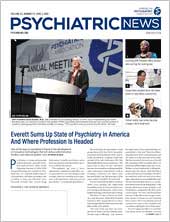Dr. Walker is a black woman and psychiatry resident who has been treating a white male patient for two months. At the most recent session, the patient referred to her as “hon” and later made some offhand comments related to blacks and crime. Dr. Walker brought this incident to her supervisor’s attention, but he simply responded that this behavior suggests that the patient feels comfortable with Dr. Walker, which is a positive development.
While this scenario was hypothetical, many minority and/or women psychiatrists have likely found themselves in similar uncomfortable situations with patients. Such situations, which have no easy resolution, were the subject of this year’s “Conversations on Diversity” session at APA’s 2018 Annual Meeting in New York.
The series was developed in 2015 by APA’s Division of Diversity and Health Equity (DDHE). The sessions provide a setting in which participants of all backgrounds and professional experience can share their perspectives about diversity, cultural sensitivity, and inclusion. APA uses feedback from these sessions to create initiatives aimed at promoting diversity in psychiatry, health equity among patients, and culturally based patient care.
At the session’s outset, DDHE Deputy Director Vabren Watts, Ph.D., highlighted the achievements that APA had made in the past year based on recommendations from the 2017 “Conversations” session, including the development of fact sheets on mental health disparities and increased marketing about the benefits of joining APA’s minority/underrepresented (M/UR) caucuses, which led to the addition of 300 members to the caucuses. APA has M/UR caucuses for these groups of members: American Indian/Alaska Native/Native Hawaiian, Asian-American, black, Hispanic, international medical graduate, LGBTQ, and women psychiatrists.
“Though APA is working diligently to increase inclusion within the organization, discrimination and lack of diversity continue to exist in your daily life as a psychiatrist,” said Watts at the session’s start. He co-chaired the session with Ruth Shim, M.D., M.P.H., the Luke and Grace Kim Professor in Cultural Psychiatry at the University of California, Davis; and Eric Yarbrough, M.D., director of psychiatry at Callen-Lorde in New York and vice chair of APA’s Council on Minority Mental Health and Health Disparities.
The question that participants were asked to discuss this year was this: “What are you doing to address issues of discrimination, bias, and/or inclusivity that arise every day in your work or academic life?” As in previous “Conversation” sessions, the participants broke into small groups for discussion. Unlike previous sessions, however, they discussed specific vignettes related to clinical or administrative settings rather than answering questions solely dedicated to diversity/inclusion within APA.
One of the vignettes involved a female residency supervisor who is approached by a male resident (Dr. Martin) because a female patient he had been treating for months put in a request to switch to a female psychiatrist. Dr. Martin was confused because he thought his psychotherapy sessions were going well (see sidebar).
“We were hoping to challenge you all to have difficult conversations,” Shim said. “It may be discomfiting, but to truly listen, one has to be willing to lose a little something.”
Other session leaders—which included outgoing APA President Anita Everett, M.D., incoming APA President Altha Stewart, M.D., and APA CEO and Medical Director Saul Levin, M.D., M.P.A.—provided a range of feedback about all the scenarios and addressed sensitive topics such as when psychiatrists should be direct with patients about inappropriate comments, the major obstacles preventing minority residents from telling supervisors about inappropriate comments, and the possible career consequences of speaking up about them.
Shim thanked session participants for providing ideas that will help APA implement new diversity and inclusion initiatives as Stewart starts her term as president. Shim also thanked them for listening to each other, which will undoubtedly help them at their own institutions, she said.
“This is not the end of the conversation,” she said. “This is still just the beginning.” ■

